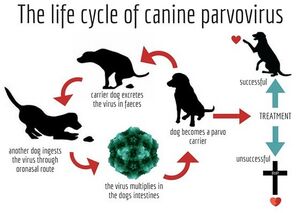Parvovirus B19: Difference between revisions
| Line 24: | Line 24: | ||
<br> The repeated citation works like this, with a forward slash.<ref name=aa/> | <br> The repeated citation works like this, with a forward slash.<ref name=aa/> | ||
practice citation: <ref name=ncbi>[https://www.ncbi.nlm.nih.gov/pmc/articles/PMC118081/#:~:text=Parvovirus%20B19%20(B19)%20was%20discovered%20serendipitously%20in%201974%20and%20is,hematologic%20status%20of%20the%20host. Heegard, E.D. and Brown, K.E. "Human Parvovirus B19." 2002. Clinical Microbiology Review 3:485-505.]</ref> | |||
In 1985 this virus was officially recognized as a member of the <i>Parvoviridae</i> family due to its similarities in genome size and density. | <i>Parvovirus B19</i> is the only member of the <i>Parvoviridae</i> family that has been found to infect human hosts. It was discovered in 1974, when a research group looking at hepatitis B surface antigens found a serum sample with unexpected results. Another lab in Japan described a similar virus in 1979 that they called "Nakatami". When compared, the two were found to be identical. | ||
In 1985 this virus was officially recognized as a member of the <i>Parvoviridae</i> family due to its similarities in genome size and density. | |||
==Section 1== | ==Section 1== | ||
Revision as of 02:13, 19 March 2024
Section

By Grace Potter
At right is a sample image insertion. It works for any image uploaded anywhere to MicrobeWiki.
The insertion code consists of:
Double brackets: [[
Filename: PHIL_1181_lores.jpg
Thumbnail status: |thumb|
Pixel size: |300px|
Placement on page: |right|
Legend/credit: Magnified 20,000X, this colorized scanning electron micrograph (SEM) depicts a grouping of methicillin resistant Staphylococcus aureus (MRSA) bacteria. Photo credit: CDC. Every image requires a link to the source.
Closed double brackets: ]]
Other examples:
Bold
Italic
Subscript: H2O
Superscript: Fe3+
Sample citations: [1]
[2]
A citation code consists of a hyperlinked reference within "ref" begin and end codes.
To repeat the citation for other statements, the reference needs to have a names: "Cite error: Closing </ref> missing for <ref> tag
Parvovirus B19 is the only member of the Parvoviridae family that has been found to infect human hosts. It was discovered in 1974, when a research group looking at hepatitis B surface antigens found a serum sample with unexpected results. Another lab in Japan described a similar virus in 1979 that they called "Nakatami". When compared, the two were found to be identical.
In 1985 this virus was officially recognized as a member of the Parvoviridae family due to its similarities in genome size and density.
Section 1
Include some current research, with at least one figure showing data.
Parvoviridae
Section 2
Include some current research, with at least one figure showing data.
Section 3
Include some current research, with at least one figure showing data.
Section 4
Conclusion
References
Authored for BIOL 238 Microbiology, taught by Joan Slonczewski,at Kenyon College,2024
